|
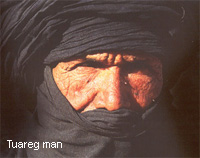 The
year was 1974. It had been a long journey
and we were dishevelled, exhausted and
hungry. There were three bottles of water
left, but I would have cheerfully handed
over my life savings for an English cup of
tea. We had driven in a tiny Citroen Deux
Chevaux from London to deep in the
Algerian Sahara traversing France, Spain
and Morocco. Now, it seemed we were on a
road to nowhere with a vast expanse of
desert interspersed with giant rocks as
far as the eye could see.
The
year was 1974. It had been a long journey
and we were dishevelled, exhausted and
hungry. There were three bottles of water
left, but I would have cheerfully handed
over my life savings for an English cup of
tea. We had driven in a tiny Citroen Deux
Chevaux from London to deep in the
Algerian Sahara traversing France, Spain
and Morocco. Now, it seemed we were on a
road to nowhere with a vast expanse of
desert interspersed with giant rocks as
far as the eye could see.
Darkness would fall
shortly and there was no sign of the
Mízab towns as our guidebook had
indicated. With the reckless
over-confidence of youth, it didnít
occur to us that we might be lost and
all that could mean. Instead, we
listened to the strains of Sawah
- a recording by the Egyptian singing
icon Abdul Halim Hafez - its grand
orchestral reverberating off the
boulders and adding to the mystique of a
never to be forgotten moment.
Mízabites
Suddenly, without warning, the tarmac road
ended and below us like a mirage stretched
a lush valley of palm groves and gardens
towered over by the minarets of the
Mízabís five towns - Ghardaia, Beni
Isguene, Bou Nouara, Melika and Al-Ateuf,
flanking a winding wadi.
We headed for the
largest town Ghardaia and in retrospect
Iím not sure whether we were more
surprised to see them or the Mízabites us.
Strangers were an uncommon sight in those
days, especially the fair-haired variety
in Western garb.
We passed though the
gate of the walled town and arrived in its
large square at prayer time when the
sounds of the muezzin echoed over the city
inviting the faithful to pray. In awe at
their piety, we watched as hundreds of
bearded men dressed in baggy Turkish-type
black trousers flooded out of their homes
and hole-in-the-wall shops in response to
the call. Others turned up on donkeys used
to trotting down the stone steps of narrow
alleyways. There wasnít a car to be seen.
Suspicious of
foreigners, a French-speaking shopkeeper
didnít encourage us to stay in the
Mízabite town after dark and so we rented
one of his summerhouses, a villa set in an
oasis outside the walls.
The nearby
town of Beni Isguene, considered holy, was
completely off-limits to non-Mízabites.
Few foreigners have been allowed a tour of
that town where music, alcohol and smoking
are forbidden. Those who have managed to
visit describe scrupulously clean streets
devoid of litter and stylish homes.
After a delicious
repast of cous-cous, I spent the night on
the villaís roof marveling at the myriad
stars, which shone brighter than anywhere
I had known before and listening to the
silence, the kind of silence that only the
desert can produce.
The Mízabites are a
secretive people and their origins are
difficult to decipher, although it is
thought that they descended from Berber
followers of Abdullah Ibn Ibad Al-Tamimi
of Basra. When their mountain stronghold
of Tiaret was destroyed by the Fatimid
Empire in AD 909, it is believed the
Ibadis fled to the Sahara for safety.
Despite the
inhospitable terrain, the Mízabites became
wealthy from the fruits of their date
palms, watered from thousands of wells
bored deep into the earth and an ingenious
irrigation system. Besides the more than
160,000 palm groves, these wells provide
water for the 100,000 inhabitants of the
Mízab and their herds.
Believers in the evil
eye, Mízabites construct their homes with
modest facades. However, their interiors
are elaborately decorated and richly
furnished. All have flat roofs where the
shy Mízabite women spend their leisure
time and they are built so close together
that a woman can hop from roof to roof so
as to visit family and friends.
Traditionally their
husbands do all the shopping or, else, the
family servant, while women are rarely
seen on the streets. Young women often
never leave their homes except on the day
they marry but on the rare occasions older
women venture forth, they are heavily
veiled, displaying only one eye.
Mízabite men are famed
throughout Algeria as accomplished
businessmen and traders and often spend
long periods away from their homeland, but
always with the thought of making enough
money to retire to the peace and
tranquillity of their beloved desert
valley.
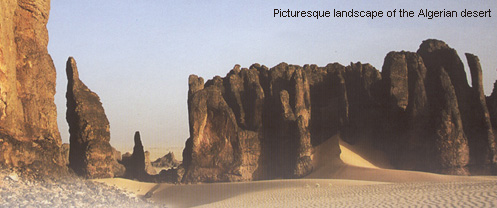
Ouled-Nail
Earlier in our journey through Algeria -
one of the most beautiful and diverse
countries in the world - we had passed the
large black tents of the Ouled-Nail
dotting a mountain range near Djelfa. Now
we were headed for Biskra, a desert
oasis town forever associated with Ouled-Nail
dancers.
At the other end of
the spectrum from the puritanical
attitudes of the Mízabites, the daughters
of the Ouled-Nail were trained in the art
of dance and song from childhood so as to
earn a living entertaining the inhabitants
of desert towns. The profession is
hereditary, and the girls would return
from their years away from the tents
adorned with necklaces of gold coins
without a blemish on their name within
their own society. There they would put
their dancing days behind them, marry and
set their sights on being good tent-wives.
Biskra was a modern
town compared to those of the Mízab with
several relatively good hotels. As luck
would have it, we arrived in the midst of
a tribal festival and soon discovered
there was no room at the inn. Instead, we
were pointed in the direction of the
townís Tourism Office, which arranged for
us a nightís accommodation in the home of
a local family.
We accepted the offer
sight unseen and found ourselves sleeping
on straw pallets on the floor along with
the occasional wandering chicken. It
seemed surreal that perched on an oak
chest of drawers was a battery-operated
record player, which boasted a single
record - Alain Barriereís Ma Vie, a
particular favourite of mine at that time.
There was no bathroom
in the mud-built house, and so the
following morning we strolled to the local
hammam or Turkish-style bath before going
in search of the Ouled-Nail dancers who
proved to be elusive.
Instead, we reached
the town square where burnoose-clad,
rifle-touting tribesmen raced on
horseback, snake charmers bedazzled the
crowd and folkloric troupes put on
traditional shows of song and dance. The
air was filled with the aroma of merguez,
a spicy red sausage, which we bought from
a stallholder and devoured with relish for
breakfast.
We spent the next
three days lounging by the pool of one of
Biskraís best hotels and basked in the
luxury of rooms with en suite baths and
the ability to order cafi au lait or ice
cream from room service. We had planned to
continue our journey to Tamanrasset, home
of Algeriaís most famous tribe - the
Toureg, otherwise known as Ďthe blue mení
but our Citroen refused to go another
mile. Once it was repaired, we thought it
prudent to return to Algiers, rather than
continuing southwards.
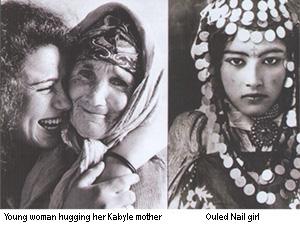
Tuareg (Les hommes bleus)
The Tuareg were once
ferocious warriors responsible for the
deaths of many an intrepid explorer and
feared by everyone who dared to cross
their territory. They were lords of the
traditional salt, slave and gold caravan
routes with a feudalistic culture and
their own written language.
Called the Blue Men due to
the indigo dyes used to colour their
robes, the Tuareg man are veiled and while
not engaged in combat once spent their
days performing elaborate tea rituals and
gathering their strength for the next
inevitable conflict.
They fought bravely and
honourably preferring to use swords,
knives and shields rather than more modern
weapons and almost always overwhelmed
their foes with their superior courage and
skills.
|
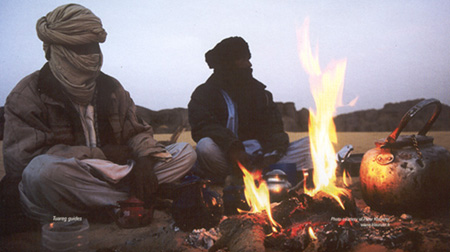 |
|
Tuareg guides |
Photo courtesy of Peter Klaunzer |
In the late 1800s, the French occupiers
of Algeria decided to build a railway
through the Sahara and were beaten back
by Tuareg warriors. Such was their
ferocity that eventually the plan was
dropped.
Archaeologist Count Byron
Khun de Prorok talks about the Tuareg in
his book Mysterious Sahara. This
1920s work describes the Tuareg as ďthe
giant white race of the SaharaĒ. Prorak
came face to face with 5,000 Tuareg,
wielding swords and was lucky not to
suffer the same fate as many of his
contemporaries, brutally killed on sight.
The Tuareg is a matriarchal
society where the women go unveiled and do
most of the work. Prorok wanted to find
the tomb of their queen Tin Hinan in the
belief that it would yield up clues to the
tribesí origin.
He finally discovered the
remains of the queen herself along with
ancient Roman coins and other
Mediterranean artifacts, as well as gold
necklaces and bracelets, all of which he
looted before the Tuareg could discover
just whose tomb it was.
Tragically, the advent of
the 20th century proved the
undoing of the Tuareg. Their legendary
horsemanship has now been relegated to a
tourist attraction while their lands are
parched from drought and stricken by
poverty. Yet they still manage to retain
their noble aspect and regal bearing.
|
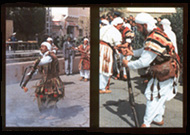
M'zabites performing traditional
tribal dance
Photos courtesy of Taha Baali,
www.mzab.free.fr |
Kabyles
On our way back to the
capital, we made a detour so as to pass
through Tizi Ouzou, the principal Berber
town, then peaceful and picturesque.
Kabyle women wearing brightly colored
dresses smiled and waved at us before we
stopped at a roadside cafi for freshly
squeezed melon juice. The owner wanted to
give us a souvenir of our visit and pulled
out a picture of his baby son Laghdar. I
was supremely touched and still cherish
it.
The Berbers, thought to be the indigenous
people of Algeria fought the Romans, the
Arabs, the Turks and the French, who spent
almost 30 years trying to take over their
mountain strongholds. Today, they are
struggling to retain their own identity,
culture and language in a country beset by
political problems.
I know that the clock canít
be turned back, but from a selfish point
of view, I long for the day when itís safe
to retrace my steps. Who knows! Perhaps I
will track down Laghdar, now a portly
pater familias; say hello to the
barbery apes of the Chiffa Gorge; walk in
the forests of Seraidi, a delightful
mountain-top village overlooking Annaba;
hunt for rose du sables (quartz rocks) in
the Sahara or immerse myself in the hot
springs at Guelma. In the meantime, like
the Tuareg, I can but dream of the past
and trust in a better future for the
long-suffering Algerian people.
|
